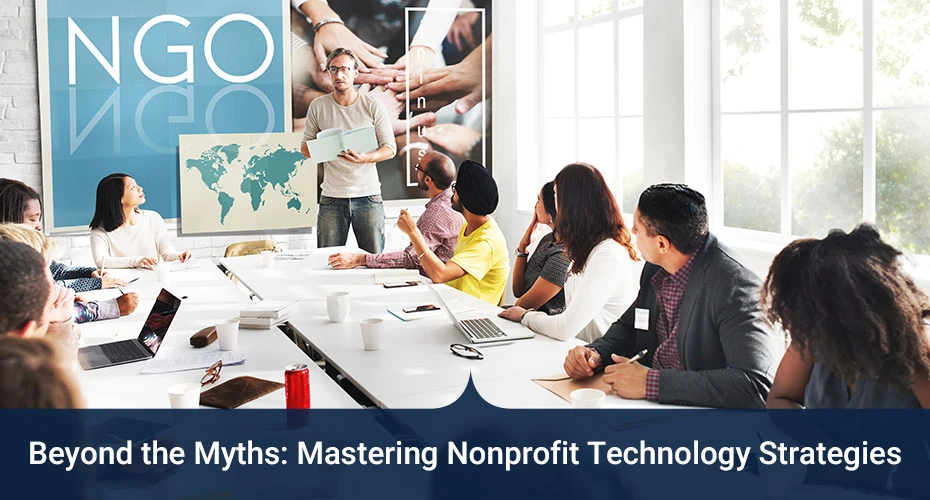To stay competitive, companies across various industries must continually update their technology to keep pace with advancements and avoid being obsolete. While this holds for businesses in almost every sector, nonprofit organizations (NPOs) are often constrained by tight budgets and poor access to technology. This puts them at risk of being left behind.

Budget scarcity has been applied to technology and has resulted in a compounding issue of technical debt accumulation that, left unchecked, could cost significantly more to unravel than if technology had been replaced at more predictable intervals.
Given technology’s critical role in modern organizational functions, nonprofits must stay technologically relevant. However, considering the sector’s frequent budget constraints and the rising shortage of personnel, how can nonprofits effectively pursue this goal?
Nonprofit consulting services can provide valuable guidance and support in navigating technological challenges and maximizing limited resources. Explore this article to dispel the five myths that commonly mislead nonprofits.
Myth 1: You Need to Make Technology Last Longer
What We’ve Heard
“We need to make technology last longer because it is expensive, and tech expense takes away from our mission.”
“Our existing platform still works after 15 years.”
What We’ve Found
- Through our research and engagements with various NPOs, we have consistently encountered technical debt as a prevalent issue among those struggling with maximizing technology. This technical debt often arises from the prolonged use of outdated systems and infrastructure.
- We’ve also observed that low utilization of available technological tools is very common. This leads to wasteful spending and challenges with data integration.
- We have seen NPOs using software that is 10+ years old and hardware that is 5+ years old, indicating a misconception about the realistic lifespan of technology. The effort required for regular upgrades is also not part of the technology conversation.
Solutions
- To solve these problems, we recommend establishing a governance program. This program will centralize decision-making on technology investments. It will also enhance the utilization of existing tools and resources.
- Regular discussions on technical debt within the technology governance program, held semi-annually, can help organizations stay proactive in managing and reducing their technical debt. These are a few things organizations must do:
- Replace 20-25% desktops annually.
- Review hardware every 3 and 5 years.
- Review major business applications every five years and minor apps annually.
- Furthermore, developing annual operational plans with budgets and goals linked to technical debt reduction can ensure that technology remains aligned with the organization’s mission and strategic objectives.
Myth 2: Modern Enterprise Technology is not Affordable
What We’ve Heard
“We’ve heard about a new platform that could benefit us, but there is no way we can afford it.”
“We can’t integrate our systems due to the cost and will simply move data manually.”
“We couldn’t afford an HRIS platform, so we built one in a SaaS project management platform.”
What We’ve Found
- Our findings reveal that many nonprofit organizations operate under the misconception that modern enterprise technology is financially out of reach. However, we have observed significant efforts by technology providers to offer discounted rates and donations specifically tailored to the nonprofit sector. For example, Microsoft donated over $3.8 billion in discounted technology in 2023 to the Nonprofit sector. Also, Microsoft is committed to doubling the number of nonprofits they serve in the next three years.
- Furthermore, we’ve found that transitioning from manual processes to automation can streamline long-term scalability while also leading to several cost and efficiency benefits in the long run.
- Despite these available opportunities, there remains a lack of awareness among nonprofits about the affordability and accessibility of modern enterprise technology solutions.
Solutions
- To overcome these misconceptions, we recommend that organizations conduct regular audits with service partners to explore available benefits and discounts tailored to nonprofits.
- Utilizing requests for proposals (RFPs) for new solutions can help organizations gain clarity on their needs. This will ensure alignment with their strategic objectives while also leveraging innovations in generative AI to streamline the process.
- Implementing a well-defined governance program can further facilitate compliance and strategic decision-making regarding technology investments, ensuring that resources are allocated efficiently and effectively.
Myth 3: You Don’t Need Modern Analytics
What We’ve Heard
“We would like to use analytics to serve our mission better, but we have failed.”
“We have chosen our own SaaS platform.”
“We can do it alone.”
What We’ve Found
- Our research has consistently demonstrated the essential role of analytics and next-generation technology in driving organizational performance and mission alignment for nonprofit organizations.
- Despite this importance, there is a common misconception among some NPOs that they either don’t need or cannot afford modern analytics solutions. This misunderstanding often stems from not fully understanding the benefits. This results in the failure to develop a comprehensive strategy for implementation, leading people to choose their own solutions and ultimately complicating the future roadmap.
- We’ve found that the absence of such a strategy leads to fragmented solutions and dependency on manual processes, hindering efficiency and scalability.
- Lastly, having the right talent is essential to drive the nonprofit’s business and mission forward. But it is equally important for seamless IT management.
Solutions
- To address these challenges, there needs to be a proactive approach to incorporating analytics into organizational decision-making processes, emphasizing the tangible benefits in terms of performance improvement and mission alignment.
- Planning for interfaces should be a foundational aspect of any new technology project, ensuring seamless integration and usability of analytics solutions.
- Additionally, analytics should remain a recurring agenda item in governance discussions and should be linked to key business performance indicators. Establishing strong technology partnerships can reinforce this commitment by providing ongoing support and guidance for aligning analytics initiatives with strategic objectives.
Myth 4: Funding/Funders Dictate Where Tech Spend Goes
What We’ve Heard
“We need to follow specific rules while spending funds.”
“In our organization, some “missions” spend more aggressively than others on technology, and the back office may struggle to keep up.”
What We’ve Found
- Our findings indicate that many nonprofit organizations perceive their technology spending as dictated by external funding sources, leading to unbalanced investments and strategic misalignment.
- We’ve observed instances where IT spending is treated as tactical rather than strategic, often due to a lack of consideration for technology lifespan and long-term planning.
- The proliferation of cloud-based solutions with easy monthly subscription plans has further complicated matters, creating challenges for budgeting and strategic allocation of resources.
Solutions
- To address these challenges, organizations should prioritize return on investment when evaluating and approving technology projects, ensuring that spending aligns with strategic objectives.
- Establishing technology spending as a recurring topic for technology governance teams can help facilitate ongoing discussions and strategic decision-making.
- When IT and finance departments collaborate, they must analyze technology spending and create a budget that aligns with the organization’s goals. This collaboration is especially effective when the CIO and CFO work together. By teaming up, they can ensure that the technology budget is well-suited to the organization’s needs. This partnership allows for a more strategic approach to technology spending.
Myth 5: Technology Advancement is IT’s Responsibility
What We’ve Heard
“IT doesn’t move fast enough to meet our organization’s needs.”
“We’ve wanted to leverage new technologies for years but have never made it happen.”
“Past attempts at technology transformation have failed.”
What We’ve Found
- Despite established technology policies, organizational processes often undergo adaptations that deviate from established guidelines, leading to potential inefficiencies and inconsistencies.
- In some instances, organizational process owners may lack the platform or authority to initiate changes to existing processes, hindering their ability to address inefficiencies or implement improvements effectively.
- The presence of siloed technology and business departments creates barriers to effective collaboration and coordination. This fragmentation hampers the planning and execution of IT transformation initiatives, limiting the organization’s ability to leverage technology effectively.
Solutions
- Establishing a transparent decision-making framework ensures that proposed solutions are evaluated objectively and aligned with organizational objectives. This promotes consistency in the selected solution.
- Regular maintenance and review of the IT roadmap, involving both business and IT leaders, facilitates the alignment of technology initiatives with organizational priorities. This ensures that IT investments support strategic goals and adapt to changing business needs.
- Utilizing a business analyst to manage requirements across stakeholders enhances communication and alignment between different business units and IT teams. The business analyst serves as a bridge, translating business needs into technical requirements and ensuring that solutions meet the needs of all stakeholders.
- Hosting planning workshops involving multiple subject matter experts fosters a comprehensive discussion and analysis of technology issues. These workshops provide a forum for cross-functional collaboration, allowing stakeholders to collectively address complex challenges and develop holistic solutions.
Empowering Nonprofits with Strategic Technology Solutions
The digital landscape is constantly evolving, and nonprofits can’t afford to be left behind. While budget constraints and resource limitations are real challenges, nonprofits now need to take a proactive stance on technology.
By partnering with the right technology providers and adopting strategic frameworks recommended by consulting services for nonprofit organizations, you can bridge the tech gap, increase efficiency, and, ultimately, further your mission.
Start your journey today!
About the Author
Jerry McGlynn is Practice Director, Consulting at Synoptek. With over 31 years of IT Consulting and Strategy Development experience, Jerry is not just a technologist but also a business leader who can transform operations and drive effective change management. He is a sought-after change agent with an extensive track record of transforming struggling IT organizations into world-class operators.



